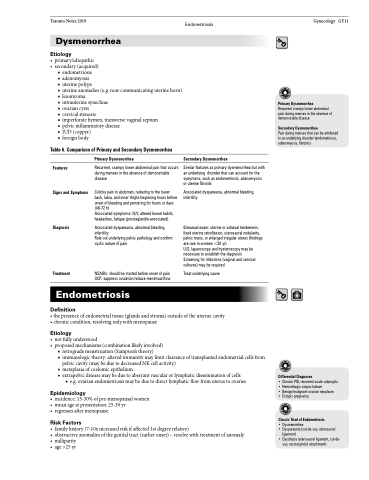Page 497 - TNFlipTest
P. 497
Toronto Notes 2019
Endometriosis
Gynecology GY11
Dysmenorrhea
Etiology
• primary/idiopathic
• secondary(acquired)
■ endometriosis
■ adenomyosis
■ uterine polyps
■ uterine anomalies (e.g. non-communicating uterine horn) ■ leiomyoma
■ intrauterine synechiae
■ ovariancysts
■ cervical stenosis
■ imperforate hymen, transverse vaginal septum ■ pelvic inflammatory disease
■ IUD(copper) ■ foreignbody
Table 6. Comparison of Primary and Secondary Dysmenorrhea
Primary Dysmenorrhea
Recurrent crampy lower abdominal pain during menses in the absence of demonstrable disease
Secondary Dysmenorrhea
Pain during menses that can be attributed to an underlying disorder (endometriosis, adenomyosis, fibroids)
Features
Signs and Symptoms
Diagnosis
Treatment
Primary Dysmenorrhea
Recurrent, crampy lower abdominal pain that occurs during menses in the absence of demonstrable disease
Colicky pain in abdomen, radiating to the lower back, labia, and inner thighs beginning hours before onset of bleeding and persisting for hours or days (48-72 h)
Associated symptoms: N/V, altered bowel habits, headaches, fatigue (prostaglandin-associated)
Associated dyspareunia, abnormal bleeding, infertility
Rule out underlying pelvic pathology and confirm cyclic nature of pain
NSAIDs: should be started before onset of pain OCP: suppress ovulation/reduce menstrual flow
Secondary Dysmenorrhea
Similar features as primary dysmenorrhea but with an underlying disorder that can account for the symptoms, such as endometriosis, adenomyosis or uterine fibroids
Associated dyspareunia, abnormal bleeding, infertility
Bimanual exam: uterine or adnexal tenderness, fixed uterine retroflexion, uterosacral nodularity, pelvic mass, or enlarged irregular uterus (findings are rare in women <20 yr)
U/S, laparoscopy and hysteroscopy may be necessary to establish the diagnosis Screening for infections (vaginal and cervical cultures) may be required
Treat underlying cause
Endometriosis
Definition
• the presence of endometrial tissue (glands and stroma) outside of the uterine cavity • chronic condition, resolving only with menopause
Etiology
• notfullyunderstood
• proposedmechanisms(combinationlikelyinvolved)
■ retrograde menstruation (Sampson’s theory)
■ immunologic theory: altered immunity may limit clearance of transplanted endometrial cells from
pelvic cavity (may be due to decreased NK cell activity)
■ metaplasia of coelomic epithelium
■ extrapelvic disease may be due to aberrant vascular or lymphatic dissemination of cells
◆ e.g. ovarian endometriosis may be due to direct lymphatic flow from uterus to ovaries
Epidemiology
• incidence:15-30%ofpre-menopausalwomen • meanageatpresentation:25-30yr
• regressesaftermenopause
Risk Factors
• familyhistory(7-10xincreasedriskifaffected1stdegreerelative)
• obstructiveanomaliesofthegenitaltract(earlieronset)–resolvewithtreatmentofanomaly • nulliparity
• age>25yr
Differential Diagnoses
• Chronic PID, recurrent acute salpingitis • Hemorrhagic corpus luteum
• Benign/malignant ovarian neoplasm
• Ectopic pregnancy
Classic Triad of Endometriosis
• Dysmenorrhea
• Dyspareunia (cul-de-sac, uterosacral
ligament)
• Dyschezia (uterosacral ligament, cul-de-
sac, rectosigmoid attachment)


